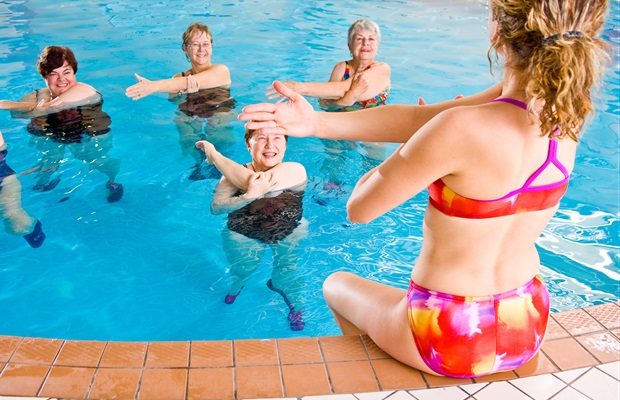 Reviewed
Reviewed
Aquatic HIIT improves exercise capacity in adults with chronic conditions
 Reviewed
Reviewed
High-intensity interval training in water, often called aquatic HIIT (AHIIT) improves exercise capacity in adults with chronic conditions and has a similar impact as land based training (LBHIIT), suggests research published in the open access journal BMJ Open Sport & Exercise Medicine.
The researchers say AHIIT may provide a safe and valuable alternative for people with chronic conditions who are unable to perform LBHIIT.
HIIT is a type of interval training exercise that involves brief bursts of high intensity movements followed by short recovery periods of lower intensity movements.
HIIT is considered to have more health benefits than moderate-intensity exercise for people with and without chronic conditions. It increases aerobic capacity and endurance while being time efficient, making it an attractive exercise option.
Exercising in water can also help to relieve pressure on joints, allowing people to complete movements they cannot do on land, but there is conflicting evidence on its physiological benefits.
To investigate the effect of AHIIT, the researchers analysed 18 trials that compared how AHIIT improved participants' exercise capacity (measured by oxygen consumption, walking tests and physical fitness tests) with LBHIIT, moderate-intensity exercise in water (AMICT) or a non-exercising control group.
The trials were of varying quality, but the researchers were able to assess the certainty of evidence using the recognised GRADE system.
Some 868 participants (74% women) were included who had a range of conditions including back pain, arthritis, chronic lung disease (COPD), type 2 diabetes, and multiple sclerosis. Some participants had more than one chronic condition.
Differences between groups were expressed as standardised mean differences (SMD). Generally, an SMD of 0.2-0.5 indicates a small effect, 0.5-0.8 a moderate effect, and 0.8 or more a large effect.
The results show that AHIIT moderately improved participants' exercise capacity compared with no exercise (SMD 0.78) and had a small beneficial effect compared with AMICT (SMD 0.45), but no difference in exercise capacity was seen for AHIIT compared with LBHIIT.
There were fewer adverse events reported in AHIIT than with LBHIIT, and adherence rates for AHIIT ranged from 84% to 100%.
This is an observational study, and the researchers acknowledge that some of the trials did not include a blind assessor, which may have affected results, and none of the studies looked at long term improvements on exercise capacity or quality of life.
However, the detailed search strategy and inclusion of several chronic conditions, adverse events and adherence enabled a greater depth of understanding of AHIIT in a variety of populations.
"A key finding of this meta-analysis indicates that AHIIT may be as beneficial as LBHIIT, which gives people with chronic conditions another choice for effective HIIT or potentially a more successful environment to start and continue with high-intensity training," say the researchers, adding that the natural support and buoyancy of water "may facilitate this effectiveness."
And they suggest that future research should examine the link between exercise capacity and key patient-related outcomes, barriers to HIIT and the ongoing independent commitment to exercise.
BMJ
Bunæs-Næss, H., et al. (2023). Aquatic high-intensity interval training (HIIT) may be similarly effective to land-based HIIT in improving exercise capacity in people with chronic conditions: a systematic review and meta-analysis. BMJ Open Sport & Exercise Medicine. doi.org/10.1136/bmjsem-2023-001639.
Posted in: Medical Science News | Medical Research News | Healthcare News
Tags: Arthritis, Back Pain, Chronic, Diabetes, Exercise, Lung Disease, Medicine, Multiple Sclerosis, Oxygen, Pain, Research, Sclerosis, Type 2 Diabetes, Walking